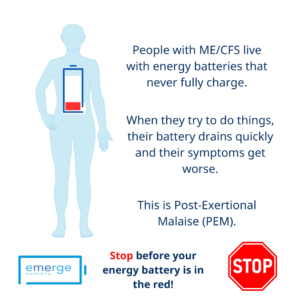Helping you understand the energy limits of ME/CFS and long COVID
Post-exertional malaise (PEM) is a core symptom of ME/CFS, and a common symptom in long COVID. PEM is when your symptoms get worse after physical, mental or emotional exertion. It means that you feel sicker after doing things like having a shower, going for a walk or even just reading a book.
PEM happens because your body doesn’t make as much energy at a cellular level as a healthy person. It is like a battery that never fully recharges and that drains faster than a healthy battery. When the energy in your battery gets low, your symptoms get worse.
Stop. Rest. Pace.
Unfortunately, there is no cure for PEM. The best way to manage your condition is to learn how to stop your energy draining too fast to help reduce your symptoms, and to learn how to make the most of the energy you do have. This is called Stop Rest Pace.
Stop
Stop activity before you experience symptoms, or as soon as you notice an increase in symptoms. Rest
Take regular rest breaks throughout the day, and during activities.
Pace
Break your activities up with periods of rest to allow your battery to charge. Everyone is different, so it is important for you to get to know how much you can do and how much rest you need.

Some questions to consider:
- How much rest do you need to rechare? Are you getting enough?
- Are you constantly draining your battery without taking time to charge?
- Do you need to build in more rest time?
What is the best way to rest?
There are many different ways to rest! The best way to rest is the way that works best for you.
For some, complete rest involves absolutely minimal activity, which means no stimulation such as TV, social media, reading or listening to music.
For others, it might be listening to a guided meditation or sitting in nature.
And others find that complete stillness isn’t restful for them, and so things like playing a game on their phone or doing an easy puzzle allows their body and mind to rest.
You may want to try different strategies to see what works best for you.
What is Pacing?
The aim of pacing is to leave some energy in your battery at the end of the activity to make it easier for your energy battery to recharge. It involves undertaking less activity than what you have energy for on a given day, and breaking activities down into short bursts with rest breaks in between. For example, instead of taking a shower, brushing your teeth and combing your hair in one go, you might take a shower and then rest until you feel ready to undertake the next activity.
Some ME/CFS doctors advise people living with PEM to try to do no more than 50-60% of what they feel they can do.
Pacing, like any other skill, must be practised. It becomes easier over time.
Be realistic
In an ideal world, you would always be able to stay within your energy limits and would never experience PEM, but this is not very realistic. If you have work or family commitments or live alone, your daily life may take you beyond your energy limits.
And sometimes there are activities that you want to do and are important for overall wellbeing, but will take you outside of your energy limits.
Pacing is a tool to help you manage your condition. It isn’t magic and it’s not a cure. It is important to be flexible and realistic with your pacing and try to build pacing into your everyday life.
Remember – your battery is not the same as when you were healthy. Even when you are resting and pacing, what you can do in a day will be less than before.
How to get support with Pacing
Our free Telehealth Support Service provides assistance with symptom management and guidance on pacing.


